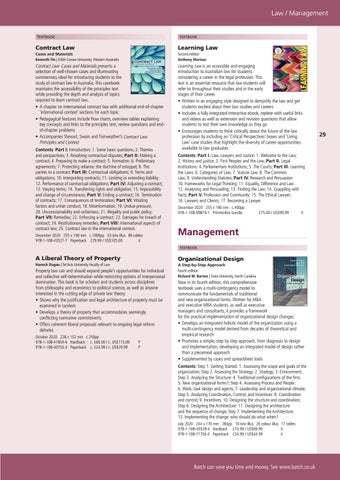Law / Management
TEXTBOOK
TEXTBOOK
Contract Law
Learning Law
Cases and Materials Kenneth Yin | Edith Cowan University, Western Australia
Second edition Anthony Marinac
Contract Law: Cases and Materials presents a selection of well-chosen cases and illuminating commentary ideal for introducing students to the study of contract law in Australia. This casebook maintains the accessibility of the principles text while providing the depth and analysis of topics required to learn contract law. • A chapter on international contract law with additional end-of-chapter ‘international context’ sections for each topic • Pedagogical features include flow charts, overview tables explaining key concepts and links to the principles text, review questions and endof-chapter problems • Accompanies Stewart, Swain and Fairweather’s Contract Law: Principles and Context Contents: Part I: Introduction; 1. Some basic questions; 2. Themes and perspectives; 3. Resolving contractual disputes; Part II: Making a contract; 4. Preparing to make a contract; 5. Formation; 6. Preliminary agreements; 7. Protecting reliance: the doctrine of estoppel; 8. The parties to a contract; Part III: Contractual obligations; 9. Terms and obligations; 10. Interpreting contracts; 11. Limiting or extending liability; 12. Performance of contractual obligations; Part IV: Adjusting a contract; 13. Varying terms; 14. Transferring rights and obligation; 15. Impossibility and change of circumstances; Part V: Ending a contract; 16. Termination of contracts; 17. Consequences of termination; Part VI: Vitiating factors and unfair conduct; 18. Misinformation; 19. Undue pressure; 20. Unconscionability and unfairness; 21. Illegality and public policy; Part VII: Remedies; 22. Enforcing a contract; 23. Damages for breach of contract; 24. Restitutionary remedies; Part VIII: International aspects of contract law; 25. Contract law in the international context.
Learning Law is an accessible and engaging introduction to Australian law for students considering a career in the legal profession. This text is an essential resource that law students will refer to throughout their studies and in the early stages of their career. • Written in an engaging style designed to demystify the law and get students excited about their law studies and careers • Includes a fully integrated interactive ebook, replete with useful links and videos as well as extension and revision questions that allow students to test their own knowledge as they go • Encourages students to think critically about the future of the law profession by including an ‘Critical Perspectives’ boxes and ‘Living Law’ case studies that highlight the diversity of career opportunities available to law graduates
December 2020 255 x 190 mm c.1000pp 63 b/w illus. 86 tables 978-1-108-43527-7 Paperback £79.99 / US$105.00 X
Contents: Part I. Law, Lawyers and Justice: 1. Welcome to the Law; 2. History and justice; 3. First Peoples and the Law; Part II. Legal Institutions: 4. Parliamentary Institutions; 5. The Courts; Part III. Learning the Laws: 6. Categories of Law; 7. Statute Law; 8. The Common Law; 9. Understanding Statutes; Part IV. Research and Persuasion: 10. Frameworks for Legal Thinking; 11. Equality, Difference and Law 12. Analysing and Persuading; 13. Finding the Law; 14. Grappling with Facts; Part V. Profession and Community: 15. The Ethical Lawyer; 16. Lawyers and Clients; 17. Becoming a Lawyer. December 2020 255 x 190 mm c.400pp 978-1-108-90819-1 Print/online bundle
£75.00 / US$99.99
X
Management TEXTBOOK
A Liberal Theory of Property
Organizational Design
Hanoch Dagan | Tel Aviv University Faculty of Law
Property law can and should expand people’s opportunities for individual and collective self-determination while restricting options of interpersonal domination. This book is for scholars and students across disciplines from philosophy and economics to political science, as well as anyone interested in the cutting edge of private law theory. • Shows why the justification and legal architecture of property must be examined in tandem • Develops a theory of property that accommodates seemingly conflicting normative commitments • Offers coherent liberal proposals relevant to ongoing legal reform debates October 2020 228 x 152 mm c.250pp 978-1-108-41854-6 Hardback c. £60.00 / c. US$115.00 978-1-108-40753-3 Paperback c. £24.99 / c. US$29.99
P P
A Step-by-Step Approach Fourth edition Richard M. Burton | Duke University, North Carolina
Now in its fourth edition, this comprehensive textbook uses a multi-contingency model to communicate the fundamentals of traditional and new organizational forms. Written for MBA and executive MBA students, as well as executive managers and consultants, it provides a framework for the practical implementation of organizational design changes. • Develops an integrated holistic model of the organization using a multi-contingency model derived from decades of theoretical and empirical research • Promotes a simple, step by step approach, from diagnosis to design and implementation, developing an integrated model of design rather than a piecemeal approach • Supplemented by cases and spreadsheet tools Contents: Step 1. Getting Started: 1. Assessing the scope and goals of the organization; Step 2. Assessing the Strategy: 2. Strategy; 3. Environment; Step 3. Analyzing the Structure: 4. Traditional configurations of the firm; 5. New organizational forms?; Step 4. Assessing Process and People: 6. Work, task design and agents; 7. Leadership and organizational climate; Step 5. Analyzing Coordination, Control, and Incentives: 8. Coordination and control; 9. Incentives; 10. Designing the structure and coordination; Step 6. Designing the Architecture: 11. Designing the architecture and the sequence of change; Step 7. Implementing the Architecture: 12. Implementing the change: who should do what when? July 2020 244 x 170 mm 284pp 10 b/w illus. 26 colour illus. 17 tables 978-1-108-49328-4 Hardback £74.99 / US$99.99 X 978-1-108-71756-4 Paperback £34.99 / US$44.99 X
Batch can save you time and money. See www.batch.co.uk
29

